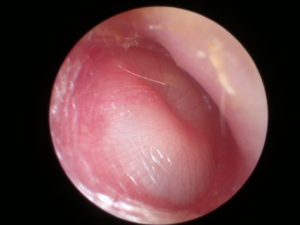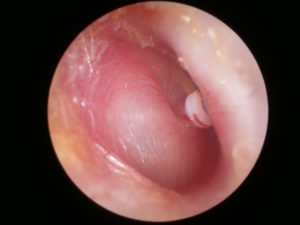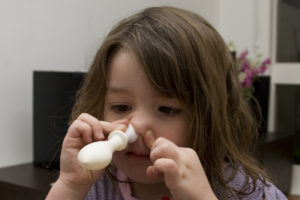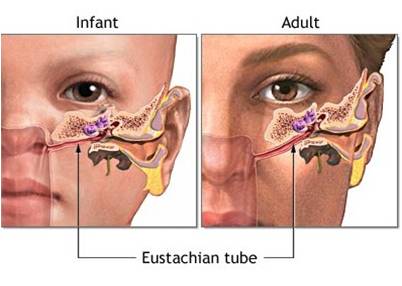Indications for Tympanostomy Tubes (Ventilation Tubes or Grommets)
Otitis media with effusion (OME) is the term to describe the presence of fluid within the middle ear, whether it be serous, purulent or mucoid. The commonest synonym is is glue ear.
In general terms, two thirds of children will be affected by otitis media before the age of 3, with 80% of children before 7 having at least one episode of Acute Otitis Media (AOM). 80% resolve within 7-14 days, and in 80% the effusion has cleared within 3 months. Once an effusion has been present for 3 months, however, only 30% will resolve over the ensuing year. 1
The underlying pathophysiology of AOM and OME is related to Eustachian tube dysfunction. Anatomical factors in children are a narrow lumen, and a flatter trajectory to the nasopharynx. The presence of adnoid tissue (commonly), or other mass effects placing pressure on the tube are also factors. Functional factors are any that effects nasal mucosa, and thus the Eustachian tube lining. Most commonly this is related to recurrent viral URTIs, but can also be affected by rhinitis. Adenoids, even if small can act as a reservoir for infection and inflammation.
The use of, and timing of insertion of tympanostomy tubes remains controversial. 1,2 3 Accurate assessment is difficult and must be conducted by a skilled practitioner. The addition of pneumatic otoscopy is essential, as is audiological testing.

A microscopic view of the right ear. This is the classic appearance of glue ear, with a mucopurulent effusion present behind the drum.

A photo taken immediately following ventilation (grommet) insertion. It is placed into the antero-inferior aspect of the ear drum.
Hearing disability can affect communication, speech, learning and behaviour. In properly selected patients, tympanostomy tubes have been shown to significantly improve language development, reduce the frequency and severity of acute otitis media and reduce the severity of chronic ear disease.4,5 Possibily even more importantly they result in a significant improvement in quality of life.6,7
In summary consideration for tympanostomy tube insertion in children are:
Bilateral middle ear effusions for more than 3 months, accompanied by a moderate to severe conductive hearing loss, and or evidence of speech or language delay. Those with only mild hearing loss, and without a history of recurrent acute otitis media can be safely observed for 6-12 months in terms of long term language development. 2
A unilateral effusion for more than 6-12 months, and recurrent AOM of more than 4 episodes per year, especially if severe or prolonged are independent indications for insertion.
During the observation period it is worthwhile to treat with one full course of appropriate oral antibiotics and encourage exercises to improve eustachian tube function. These include the blowing up of balloons, bubbling water through a straw and valsalva manoevres if able. The use of the otovent device can be helpful in this regard, and in toddlers and young children can be introduced as a game.

Use of the otovent device. A nozzle is placed into one nostril while the other is occluded. Then an attempt is made to inflate the balloon, which provides a safe level of resistance. Most 3-4 year olds can use this device.
Indications for more prompt insertion are those rare effusions causing a significant conductive hearing loss, those with a pre-existing hearing loss, significant learning and speech delay and those with anatomical abnormalities such as cleft palate.
Approximately 20% of children may need a second set of tympanostomy tubes. Traditionally it was recommended that an adenoidectomy is performed regardless of the size of the adenoids, at the placement of the second set of tubes, although I now recommend strong consideration of adenoidectomy and endoscpic vision at the placenement of the first set of tubes, unless there are strong contra-indications.8 Other conditions such as allergy and reflux disease play an important role in a subset of patients.9,10
Tympanostomy insertion is not risk free. It requires an anaesthetic, and otorrhoea is a common but rarely persistent problem during the period of tympanostomy tube patency. Water precautions during swimming and bathing are recommended, but only provides a slight decrease in the incidence of otorrhoea. 11 Overall there is a 3-4% rate of tube removal for recalcitrant otorrhoea. 12 Very rarely tympanostomy tubes may need to be removed if they remain in situ for greater than 2 years. Surgical removal and recurrent insertion increases the rare risk of tympanic membrane perforation.
Follow up is important, with 3-6 monthly visits imperative. Full assessment is required once the tympanostomy tubes have extruded to ensure persisting middle ear ventilation.
Exceptional indications for tympanostomy tube insertion may include the treatment of severe tympanic membrane retraction; prevention of barotruama in hyperbaric oxygen therapy and rarely for flying; as a port for administration of medication in the management of Meniere’s disease
Finally be wary of an unilateral effusion in the adult patient. Neoplasia must be excluded. The nasopharynx must be visualized and the skull base and tegmen (roof of the middle ear) must be imaged.
References
1. Darrow DH, Dash N, Derkay CS. Otitis media: concepts and controversies. Current opinion in otolaryngology & head and neck surgery 2003;11:416-423.
2. Paradise JL, Feldman HM, Campbell TFet al. Tympanostomy tubes and developmental outcomes at 9 to 11 years of age. The New England journal of medicine 2007;356:248-261.
3. Paradise JL, Bluestone CD. Consultation with the specialist: tympanostomy tubes: a contemporary guide to judicious use. Pediatrics in review / American Academy of Pediatrics 2005;26:61-66.
4. Diacova S, McDonald TJ. A comparison of outcomes following tympanostomy tube placement or conservative measures for management of otitis media with effusion. Ear, nose, & throat journal 2007;86:552-554.
5. Bennett KE, Haggard MP, Silva PAet al. Behaviour and developmental effects of otitis media with effusion into the teens. Archives of disease in childhood 2001;85:91-95.
6. Rosenfeld RM, Bhaya MH, Bower CMet al. Impact of tympanostomy tubes on child quality of life. Archives of otolaryngology–head & neck surgery 2000;126:585-592.
7. Richards M, Giannoni C. Quality-of-life outcomes after surgical intervention for otitis media. Archives of otolaryngology–head & neck surgery 2002;128:776-782.
8. Kadhim AL, Spilsbury K, Semmens JB, Coates HL, Lannigan FJ. Adenoidectomy for middle ear effusion: a study of 50,000 children over 24 years. The Laryngoscope 2007;117:427-433.
9. Tewfik TL, Mazer B. The links between allergy and otitis media with effusion. Current opinion in otolaryngology & head and neck surgery 2006;14:187-190.
10. Crapko M, Kerschner JE, Syring M, Johnston N. Role of extra-esophageal reflux in chronic otitis media with effusion. The Laryngoscope 2007;117:1419-1423.
11. Goldstein NA, Mandel EM, Kurs-Lasky M, Rockette HE, Casselbrant ML. Water precautions and tympanostomy tubes: a randomized, controlled trial. The Laryngoscope 2005;115:324-330.
12. Ryding M, White P, Kalm O. Course and long-term outcome of ‘refractory’ secretory otitis media. The Journal of laryngology and otology 2005;119:113-118.
Tympanostomy Tubes in Children (Ventilating Tubes or Grommets)
An excellent supplement has been published this month in Otolaryngology — Head and Neck Surgery 2013 149: S1, exploring the evidence behind insertion of and management of ventilating tubes in children
Clinical Practice Guideline: Tympanostomy Tubes in Children
http://oto.sagepub.com/content/149/1_suppl/S1
The British Television Show Operation Ouch is a good way to show kids what their procedure involves

